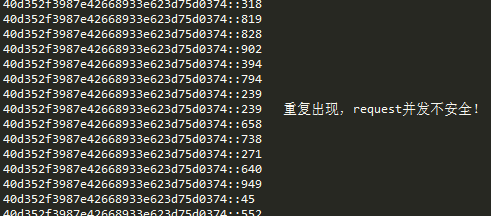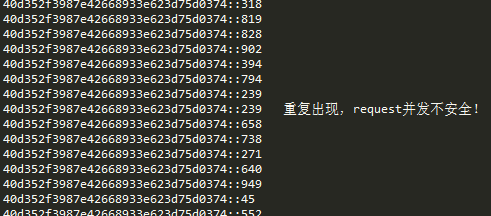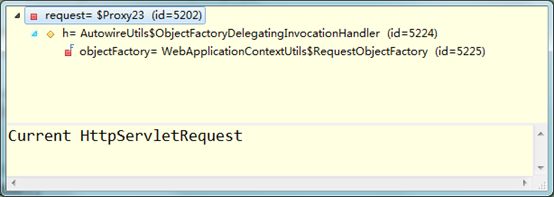Spring中获取request的几种方法,及其线程安全性分析

前言
本文将介绍在Spring MVC开发的web系统中,获取request对象的几种方法,并讨论其线程安全性。
目录
- 概述
- 如何测试线程安全性
- 方法1:Controller中加参数
- 方法2:自动注入
- 方法3:基类中自动注入
- 方法4:手动调用
- 方法5:@ModelAttribute方法
- 总结
概述
在使用Spring MVC开发Web系统时,经常需要在处理请求时使用request对象,比如获取客户端ip地址、请求的url、header中的属性(如cookie、授权信息)、body中的数据等。由于在Spring MVC中,处理请求的Controller、Service等对象都是单例的,因此获取request对象时最需要注意的问题,便是request对象是否是线程安全的:当有大量并发请求时,能否保证不同请求/线程中使用不同的request对象。
这里还有一个问题需要注意:前面所说的“在处理请求时”使用request对象,究竟是在哪里使用呢?考虑到获取request对象的方法有微小的不同,大体可以分为两类:
- 在Spring的Bean中使用request对象:既包括Controller、Service、Repository等MVC的Bean,也包括了Component等普通的Spring Bean。为了方便说明,后文中Spring中的Bean一律简称为Bean。
- 在非Bean中使用request对象:如普通的Java对象的方法中使用,或在类的静态方法中使用。
此外,本文讨论是围绕代表请求的request对象展开的,但所用方法同样适用于response对象、InputStream/Reader、OutputStream/ Writer等;其中InputStream/Reader可以读取请求中的数据,OutputStream/ Writer可以向响应写入数据。
最后,获取request对象的方法与Spring及MVC的版本也有关系;本文基于Spring4进行讨论,且所做的实验都是使用4.1.1版本。
如何测试线程安全性
既然request对象的线程安全问题需要特别关注,为了便于后面的讨论,下面先说明如何测试request对象是否是线程安全的。
测试的基本思路,是模拟客户端大量并发请求,然后在服务器判断这些请求是否使用了相同的request对象。
判断request对象是否相同,最直观的方式是打印出request对象的地址,如果相同则说明使用了相同的对象。然而,在几乎所有web服务器的实现中,都使用了线程池,这样就导致先后到达的两个请求,可能由同一个线程处理:在前一个请求处理完成后,线程池收回该线程,并将该线程重新分配给了后面的请求。而在同一线程中,使用的request对象很可能是同一个(地址相同,属性不同)。因此即便是对于线程安全的方法,不同的请求使用的request对象地址也可能相同。
为了避免这个问题,一种方法是在请求处理过程中使线程休眠几秒,这样可以让每个线程工作的时间足够长,从而避免同一个线程分配给不同的请求;另一种方法,是使用request的其他属性(如参数、header、body等)作为request是否线程安全的依据,因为即便不同的请求先后使用了同一个线程(request对象地址也相同),只要使用不同的属性分别构造了两次request对象,那么request对象的使用就是线程安全的。本文使用第二种方法进行测试。
客户端测试代码如下(创建1000个线程分别发送请求):
public class Test {
public static void main(String[] args) throws Exception {
String prefix = UUID.randomUUID().toString().replaceAll("-", "") + "::";
for (int i = 0; i < 1000; i++) {
final String value = prefix + i;
new Thread() {
@Override
public void run() {
try {
CloseableHttpClient httpClient = HttpClients.createDefault();
HttpGet httpGet = new HttpGet("http://localhost:8080/test?key=" + value);
httpClient.execute(httpGet);
httpClient.close();
} catch (IOException e) {
e.printStackTrace();
}
}
}.start();
}
}
}
服务器中Controller代码如下(暂时省略了获取request对象的代码):
@Controller
public class TestController {
// 存储已有参数,用于判断参数是否重复,从而判断线程是否安全
public static Set<String> set = new ConcurrentSkipListSet<>();
@RequestMapping("/test")
public void test() throws InterruptedException {
// …………………………通过某种方式获得了request对象………………………………
// 判断线程安全
String value = request.getParameter("key");
if (set.contains(value)) {
System.out.println(value + "/t重复出现,request并发不安全!");
} else {
System.out.println(value);
set.add(value);
}
// 模拟程序执行了一段时间
Thread.sleep(1000);
}
}
补充:上述代码原使用HashSet来判断value是否重复,经网友批评指正,使用线程不安全的集合类验证线程安全性是欠妥的,现已改为ConcurrentSkipListSet。
如果request对象线程安全,服务器中打印结果如下所示:

如果存在线程安全问题,服务器中打印结果可能如下所示:

如无特殊说明,本文后面的代码中将省略掉测试代码。
方法1:Controller中加参数
代码示例
这种方法实现最简单,直接上Controller代码:
@Controller
public class TestController {
@RequestMapping("/test")
public void test(HttpServletRequest request) throws InterruptedException {
// 模拟程序执行了一段时间
Thread.sleep(1000);
}
}
该方法实现的原理是,在Controller方法开始处理请求时,Spring会将request对象赋值到方法参数中。除了request对象,可以通过这种方法获取的参数还有很多,具体可以参见:https://docs.spring.io/spring/docs/current/spring-framework-reference/web.html#mvc-ann-methods
Controller中获取request对象后,如果要在其他方法中(如service方法、工具类方法等)使用request对象,需要在调用这些方法时将request对象作为参数传入。
线程安全性
测试结果:线程安全
分析:此时request对象是方法参数,相当于局部变量,毫无疑问是线程安全的。
优缺点
这种方法的主要缺点是request对象写起来冗余太多,主要体现在两点:
- 如果多个controller方法中都需要request对象,那么在每个方法中都需要添加一遍request参数
- request对象的获取只能从controller开始,如果使用request对象的地方在函数调用层级比较深的地方,那么整个调用链上的所有方法都需要添加request参数
实际上,在整个请求处理的过程中,request对象是贯穿始终的;也就是说,除了定时器等特殊情况,request对象相当于线程内部的一个全局变量。而该方法,相当于将这个全局变量,传来传去。
方法2:自动注入
代码示例
先上代码:
@Controller
public class TestController{
@Autowired
private HttpServletRequest request; //自动注入request
@RequestMapping("/test")
public void test() throws InterruptedException{
//模拟程序执行了一段时间
Thread.sleep(1000);
}
}
线程安全性
测试结果:线程安全
分析:在Spring中,Controller的scope是singleton(单例),也就是说在整个web系统中,只有一个TestController;但是其中注入的request却是线程安全的,原因在于:
使用这种方式,当Bean(本例的TestController)初始化时,Spring并没有注入一个request对象,而是注入了一个代理(proxy);当Bean中需要使用request对象时,通过该代理获取request对象。
下面通过具体的代码对这一实现进行说明。
在上述代码中加入断点,查看request对象的属性,如下图所示:

在图中可以看出,request实际上是一个代理:代理的实现参见AutowireUtils的内部类ObjectFactoryDelegatingInvocationHandler:
/**
* Reflective InvocationHandler for lazy access to the current target object.
*/
@SuppressWarnings("serial")
private static class ObjectFactoryDelegatingInvocationHandler implements InvocationHandler, Serializable {
private final ObjectFactory<?> objectFactory;
public ObjectFactoryDelegatingInvocationHandler(ObjectFactory<?> objectFactory) {
this.objectFactory = objectFactory;
}
@Override
public Object invoke(Object proxy, Method method, Object[] args) throws Throwable {
// ……省略无关代码
try {
return method.invoke(this.objectFactory.getObject(), args); // 代理实现核心代码
}
catch (InvocationTargetException ex) {
throw ex.getTargetException();
}
}
}
也就是说,当我们调用request的方法method时,实际上是调用了由objectFactory.getObject()生成的对象的method方法;objectFactory.getObject()生成的对象才是真正的request对象。
继续观察上图,发现objectFactory的类型为WebApplicationContextUtils的内部类RequestObjectFactory;而RequestObjectFactory代码如下:
/**
* Factory that exposes the current request object on demand.
*/
@SuppressWarnings("serial")
private static class RequestObjectFactory implements ObjectFactory<ServletRequest>, Serializable {
@Override
public ServletRequest getObject() {
return currentRequestAttributes().getRequest();
}
@Override
public String toString() {
return "Current HttpServletRequest";
}
}
其中,要获得request对象需要先调用currentRequestAttributes()方法获得RequestAttributes对象,该方法的实现如下:
/**
* Return the current RequestAttributes instance as ServletRequestAttributes.
*/
private static ServletRequestAttributes currentRequestAttributes() {
RequestAttributes requestAttr = RequestContextHolder.currentRequestAttributes();
if (!(requestAttr instanceof ServletRequestAttributes)) {
throw new IllegalStateException("Current request is not a servlet request");
}
return (ServletRequestAttributes) requestAttr;
}
生成RequestAttributes对象的核心代码在类RequestContextHolder中,其中相关代码如下(省略了该类中的无关代码):
public abstract class RequestContextHolder {
public static RequestAttributes currentRequestAttributes() throws IllegalStateException {
RequestAttributes attributes = getRequestAttributes();
// 此处省略不相关逻辑…………
return attributes;
}
public static RequestAttributes getRequestAttributes() {
RequestAttributes attributes = requestAttributesHolder.get();
if (attributes == null) {
attributes = inheritableRequestAttributesHolder.get();
}
return attributes;
}
private static final ThreadLocal<RequestAttributes> requestAttributesHolder =
new NamedThreadLocal<RequestAttributes>("Request attributes");
private static final ThreadLocal<RequestAttributes> inheritableRequestAttributesHolder =
new NamedInheritableThreadLocal<RequestAttributes>("Request context");
}
通过这段代码可以看出,生成的RequestAttributes对象是线程局部变量(ThreadLocal),因此request对象也是线程局部变量;这就保证了request对象的线程安全性。
优缺点
该方法的主要优点:
- 注入不局限于Controller中:在方法1中,只能在Controller中加入request参数。而对于方法2,不仅可以在Controller中注入,还可以在任何Bean中注入,包括Service、Repository及普通的Bean。
- 注入的对象不限于request:除了注入request对象,该方法还可以注入其他scope为request或session的对象,如response对象、session对象等;并保证线程安全。
- 减少代码冗余:只需要在需要request对象的Bean中注入request对象,便可以在该Bean的各个方法中使用,与方法1相比大大减少了代码冗余。
但是,该方法也会存在代码冗余。考虑这样的场景:web系统中有很多controller,每个controller中都会使用request对象(这种场景实际上非常频繁),这时就需要写很多次注入request的代码;如果还需要注入response,代码就更繁琐了。下面说明自动注入方法的改进方法,并分析其线程安全性及优缺点。
方法3:基类中自动注入
代码示例
与方法2相比,将注入部分代码放入到了基类中。
基类代码:
public class BaseController {
@Autowired
protected HttpServletRequest request;
}
Controller代码如下;这里列举了BaseController的两个派生类,由于此时测试代码会有所不同,因此服务端测试代码没有省略;客户端也需要进行相应的修改(同时向2个url发送大量并发请求)。
@Controller
public class TestController extends BaseController {
// 存储已有参数,用于判断参数value是否重复,从而判断线程是否安全
public static Set<String> set = new ConcurrentSkipListSet<>();
@RequestMapping("/test")
public void test() throws InterruptedException {
String value = request.getParameter("key");
// 判断线程安全
if (set.contains(value)) {
System.out.println(value + "/t重复出现,request并发不安全!");
} else {
System.out.println(value);
set.add(value);
}
// 模拟程序执行了一段时间
Thread.sleep(1000);
}
}
@Controller
public class Test2Controller extends BaseController {
@RequestMapping("/test2")
public void test2() throws InterruptedException {
String value = request.getParameter("key");
// 判断线程安全(与TestController使用一个set进行判断)
if (TestController.set.contains(value)) {
System.out.println(value + "/t重复出现,request并发不安全!");
} else {
System.out.println(value);
TestController.set.add(value);
}
// 模拟程序执行了一段时间
Thread.sleep(1000);
}
}
线程安全性
测试结果:线程安全
分析:在理解了方法2的线程安全性的基础上,很容易理解方法3是线程安全的:当创建不同的派生类对象时,基类中的域(这里是注入的request)在不同的派生类对象中会占据不同的内存空间,也就是说将注入request的代码放在基类中对线程安全性没有任何影响;测试结果也证明了这一点。
优缺点
与方法2相比,避免了在不同的Controller中重复注入request;但是考虑到java只允许继承一个基类,所以如果Controller需要继承其他类时,该方法便不再好用。
无论是方法2和方法3,都只能在Bean中注入request;如果其他方法(如工具类中static方法)需要使用request对象,则需要在调用这些方法时将request参数传递进去。下面介绍的方法4,则可以直接在诸如工具类中的static方法中使用request对象(当然在各种Bean中也可以使用)。
方法4:手动调用
代码示例
@Controller
public class TestController {
@RequestMapping("/test")
public void test() throws InterruptedException {
HttpServletRequest request = ((ServletRequestAttributes) (RequestContextHolder.currentRequestAttributes())).getRequest();
// 模拟程序执行了一段时间
Thread.sleep(1000);
}
}
线程安全性
测试结果:线程安全
分析:该方法与方法2(自动注入)类似,只不过方法2中通过自动注入实现,本方法通过手动方法调用实现。因此本方法也是线程安全的。
优缺点
优点:可以在非Bean中直接获取。缺点:如果使用的地方较多,代码非常繁琐;因此可以与其他方法配合使用。
方法5:@ModelAttribute方法
代码示例
下面这种方法及其变种(变种:将request和bindRequest放在子类中)在网上经常见到:
@Controller
public class TestController {
private HttpServletRequest request;
@ModelAttribute
public void bindRequest(HttpServletRequest request) {
this.request = request;
}
@RequestMapping("/test")
public void test() throws InterruptedException {
// 模拟程序执行了一段时间
Thread.sleep(1000);
}
}
线程安全性
测试结果:线程不安全
分析:@ModelAttribute注解用在Controller中修饰方法时,其作用是Controller中的每个@RequestMapping方法执行前,该方法都会执行。因此在本例中,bindRequest()的作用是在test()执行前为request对象赋值。虽然bindRequest()中的参数request本身是线程安全的,但由于TestController是单例的,request作为TestController的一个域,无法保证线程安全。
总结
综上所述,Controller中加参数(方法1)、自动注入(方法2和方法3)、手动调用(方法4)都是线程安全的,都可以用来获取request对象。如果系统中request对象使用较少,则使用哪种方式均可;如果使用较多,建议使用自动注入(方法2 和方法3)来减少代码冗余。如果需要在非Bean中使用request对象,既可以在上层调用时通过参数传入,也可以直接在方法中通过手动调用(方法4)获得。
此外,本文在讨论获取request对象的方法时,重点讨论该方法的线程安全性、代码的繁琐程度等;在实际的开发过程中,还必须考虑所在项目的规范、代码维护等问题(此处感谢网友的批评指正)
参考文献
- https://docs.spring.io/spring/docs/4.1.x/spring-framework-reference/html/beans.html#beans-factory-scopes-other-injection
- https://docs.spring.io/spring/docs/current/spring-framework-reference/web.html#mvc-ann-methods
- https://stackoverflow.com/questions/10541934/spring-aop-and-aspect-thread-safety-for-an-autowired-httpservletrequest-bean
- http://www.phpchina.com/portal.php?mod=view&aid=40966
- https://stackoverflow.com/questions/22674044/inject-httpservletrequest-into-controller
- https://stackoverflow.com/questions/3320674/spring-how-do-i-inject-an-httpservletrequest-into-a-request-scoped-bean
- https://my.oschina.net/sluggarddd/blog/678603?fromerr=XhvpvVTi
- https://stackoverflow.com/questions/8504258/spring-3-mvc-accessing-httprequest-from-controller
- 本文标签: map session App 总结 java IO https 代码 value http 测试 安全 集合类 CTO final spring bean ip IDE zab key src 服务器 cat id CEO 开发 目录 Service servlet 数据 Proxy DOM client PHP 线程 服务端 空间 参数 线程池 UI 静态方法 HTML Developer web AOP tar 时间 list ACE tab
- 版权声明: 本文为互联网转载文章,出处已在文章中说明(部分除外)。如果侵权,请联系本站长删除,谢谢。
- 本文海报: 生成海报一 生成海报二











![[HBLOG]公众号](https://www.liuhaihua.cn/img/qrcode_gzh.jpg)

